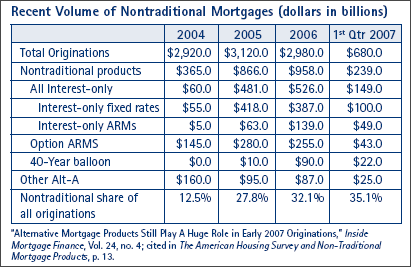March 2008
In this Issue
Is a Concept Home in Your Future?
Home Lighting and Appliance Efficiencies
Subprime Mortgage Woes May Spur Changes in AHS Data
Measuring Overcrowding in Housing
In the next issue of ResearchWorks
Subprime Mortgage Woes May Spur Changes in AHS Data
The rising rate of delinquencies and foreclosures among subprime mortgage holders has been making headlines in both the mainstream media and the financial press for more than two years. These events have sparked interest in the capacity of the American Housing Survey (AHS), a social-statistics research collaboration between HUD and the U.S. Census Bureau, to better support the study of trends in the use of nontraditional mortgages.
Could the survey's questions on mortgage finance capture information on the evolving mix of nontraditional mortgages? A new study, The American Housing Survey and Non-Traditional Mortgage Products, explores this question and offers specific recommendations for change. The analysis draws on consultations with housing analysts and previous research to evaluate the survey's usefulness in examining research and policy issues in housing finance. In addition, the study provides a line-by-line critique of the AHS with suggestions for improvement.
Initiated in 1973 and conducted in odd-numbered years, the AHS compiles a record of the physical characteristics, quality, financing mechanisms, and condition of the nation's housing stock, as well as various household characteristics. Separate AHS surveys also periodically examine these features in the housing stock of 21 major metropolitan areas. Although the AHS collects extensive information on mortgages, it is not widely used for research on housing finance.
The AHS is a housing unit survey with large sample sizes and high response rates. The quality of the mortgage information it collects depends on the ability of borrowers to understand, remember, and accurately relate the details of their financing arrangements. This reliance becomes problematic when the respondents have nontraditional mortgages with complex features, such as adjustable rate mortgages (ARMs), no-equity loans, lines of credit, reverse mortgages, and interest-only loans.

Either a mortgage can be nontraditional because of these features or because of the way it is underwritten (for example, "low-doc [umentation]" and "no-doc" loans). Whether fully understood by borrowers or not, nontraditional mortgages have grown in popularity in recent years. According to the trade journal Inside Mortgage Finance, nontraditional mortgages accounted for about one-third of all mortgage originations in 2006. In a traditional mortgage, the first payment the borrower makes is the same amount as all subsequent payments. By contrast, in nontraditional mortgages, the study explains, "the borrower faces two payment regimes: an initial regime with low payments and a second regime where payments increase to fully amortize the loan and to compensate the lender for the cost of capital and riskiness of the loan."
The long rise in housing values that began in 1992 cushioned nontraditional borrowers for more than a decade, allowing them to refinance to avoid "payment shock" when the initial payment regime came to an end. However, when housing-price appreciation slowed or fell off after 2004, an increasing number of mortgage holders found themselves trapped.
As a result, among subprime mortgages with adjustable interest rates, the number of serious delinquencies (mortgages in foreclosure or with payments overdue by 90 days or more) “rose sharply during 2006 and recently stood at about 11 percent," according to observations made by Federal Reserve Chairman Ben S. Bernanke in May 2007. In the fourth quarter of 2006, about 310,000 foreclosures were initiated, compared with an average of just 230,000 per quarter in the preceding two years, Bernanke added.
To make the AHS a better instrument for studying nontraditional mortgages, the study recommends that HUD and the U.S. Census Bureau:
-
Consider ways of highlighting mortgage data in the AHS, thus making it more flexible and easier to use;
-
Revise the questions on mortgage products to identify the most current forms of nontraditional mortgages and downplay or omit mention of certain mortgage products that are no longer common;
-
Consider broader revisions to the survey’s entire mortgage segment;
-
Make a greater effort to have respondents provide information directly from their own mortgage statements and make greater use of “dependent interviewing," using the household’s answers in previous years as a basis for current questions; and
-
Consider adding questions on additional topics, such as closing costs and the search for mortgage finance.

With this report in hand, HUD and the U.S. Census Bureau will review the proposed changes in light of factors such as “costs, change in respondent burden, likelihood that the questions will generate useful results, and the extent to which new questions could increase respondent refusals," said HUD Senior Economist David A. Vandenbroucke. New questions would have to “go through cognitive testing and OMB [Office of Management and Budget] clearance." According to Vandenbroucke, once these hurdles are passed, budget permitting, selected changes could be implemented with the 2011 American Housing Survey.
The American Housing Survey and Non-Traditional Mortgage Products is available as a free download from HUD USER at www.huduser.gov/publications/hsgfin/mortgage_prod.html.

